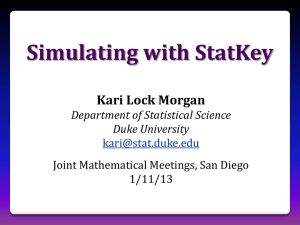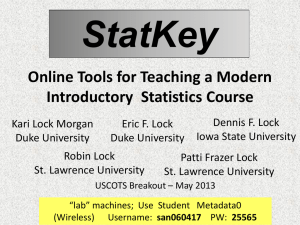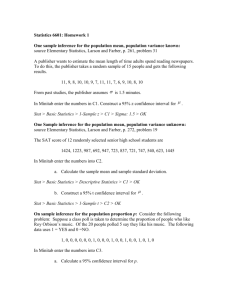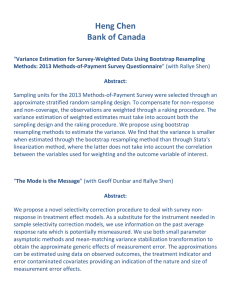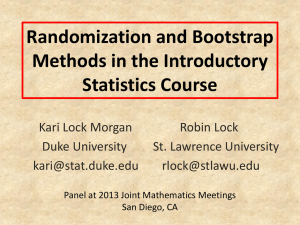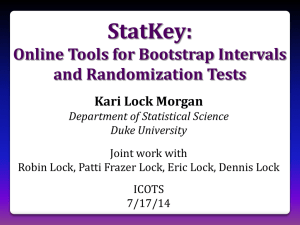Resampling Methods Advanced Biostatistics Dean C. Adams Lecture 2
advertisement
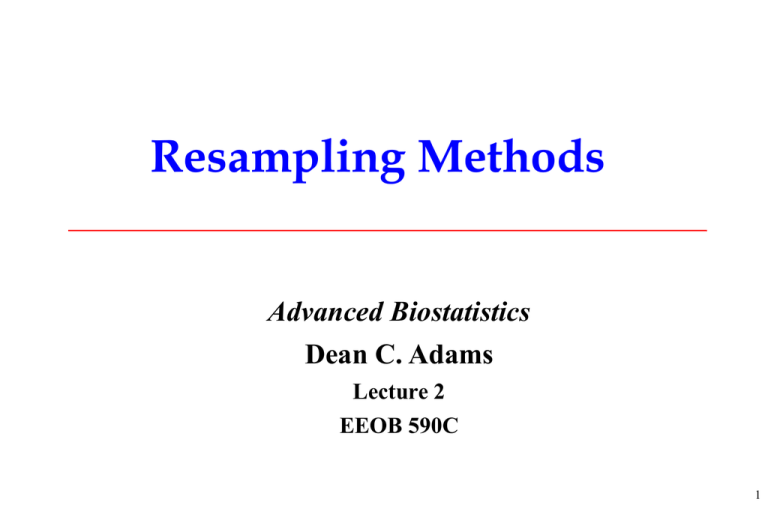
Resampling Methods Advanced Biostatistics Dean C. Adams Lecture 2 EEOB 590C 1 Inferential Statistics: Expected Distributions •Distribution of ‘expected’ values from H0 •Compare observed to expected to assess significance “How ‘extreme’ is my observed value?” •Frequentist statistics: Distributions from theory •Resampling methods: Generate expected distributions from data Observed value probability 2 Resampling Methods •Take many samples from original data set •Evaluate significance of the original based on these samples •Nonparametric (no theoretical distribution) •Very flexible (easy to assess complex designs) •Major variants: randomization, bootstrap, jackknife, Monte Carlo •Useful for testing: •Standard designs •Non-standard designs •High-dimensional data (small N; large p) 3 Randomization (Permutation) •First true randomization: Fisher’s exact test (1935) •Complete enumeration of possible pairings of data (for t-test) •Calculate observed statistic (e.g., T-statistic): Eobs •Reorder data set (i.e. randomly shuffle data) and recalculate statistic Erand •Repeat for all possible combinations and generate distribution of possible statistics •Percentage of Erand more extreme than Eobs is significance level 3 4 2 5 6 9 8 7 6 8 5 2 3 4 9 7 3 4 9 6 5 2 8 7 Eobs x 2 x1 7.5 3.5 4 ERand .1 0.5 ERand .2 0 Eobs •Note: Eobs is treated as an iteration •Randomization can be used to determine most any test statistic 4 Randomization: Example •P. cinereus & P. hoffmani: compete when sympatric •What happens to jaw morphology? Plethodon cinereus dent •Compare squamosal/dentary ratios Allopatric P. cinereus Plethodon hoffmani F = 15.47, P = 7.76 x 10-9 Sympatric P. cinereus Prand = 0.00001 (99,999 iterations) Sympatric P. hoffmani Allopatric P. hoffmani 0 0.29 0.39 0.48 0.58 0.68 Squamosal/dentary ratio Data From Adams and Rohlf (2000). PNAS 97:4106-4111. 5 General Permutation Test •All possible permutations not feasible for most cases •Use large number of iterations instead (4,999, 9,999, etc.) • ↑ # iterations improves precision of estimated significance from Adams and Anthony (1996). Anim. Behav. 51:733-738. 6 Randomization: Comments •EXTREMELY useful and flexible technique •Critical issue: What and How to resample •General procedure: shuffle dependent (Y) variables relative to X •Works for: •Standard designs (ANOVA, regression, factorial ANOVA) •Non-standard designs •Small p, large N 7 Exchangeable Units •What one shuffles matters •Designing a proper resampling test requires 1: Identifying the null hypothesis (H0) 2: Having a known expected value under H0 3: Identifying what values may be shuffled to estimate distribution under H0 •Not all things that can be shuffled should be shuffled! 8 Exchangeable Units: Example •High-dimensional PCM (phylogenetic comparative method) 1: Shuffle Y-data and re-calculate things each time (D-PGLS) 2: Calculate PICs then shuffle these (PICrand) •PICrand has high type I error rates (PICs are NOT the exchangeable units under the null hypothesis) Adams and Collyer 2015. Evol. 9 Standard Designs: T-Test / ANOVA •Assess association of X & Y •Shuffle Y relative to X: models expectations of H0 (no relationship) •Example 1: Comparison of groups (T-test or ANOVA) •Identify column representing independent variable (X) •Identify column representing dependent variables (Y): calculate F or T •Shuffle Y on X and recalculate statistic (F or T) Allopatric P. cinereus X Y X Y M M Sympatric P. cinereus Eobs Sympatric P. hoffmani Eobs F Allopatric P. hoffmani Erand F 0 0.29 0.39 0.48 0.58 0.68 Squamosal/dentary ratio •Works for multivariate Y data (shuffle ROWS of Y) 10 Standard Designs: Regression/Correlation •Example 2: Tests of Association (correlation and regression) •Identify column representing independent variable (X) •Identify column representing dependent variables (Y); calculate F or r •Shuffle Y on X and recalculate statistic (F, r, etc.) X Y X Y Eobs •Works for multivariate Y data Eobs Erand (shuffle ROWS of Y) 11 Restricted Randomization •Restrict permutation of values to sub-set of data •Useful for hypotheses where some combinations don’t make sense (or for where specific hypotheses are of interest) •Example: Two species with males and females •Compare species but preserve sexual dimorphism: Shuffle within each sex •Compare sexes but preserve species: Shuffle only within each species ♂ ♀ Spp. 1 Spp. 2 12 Factorial Models •Model: Y~A+B+A*B •Assessing factors via resampling is challenging (requires estimates of EMS for each) 1: Unrestricted Randomization: Permute Y vs. (A+B+A*B) •Can test all terms (MSA, MSB, & MSA*B) •Often the wrong H0! Conflates MS across terms (can yield uninterpretable results) 2: Restricted Randomization: Permute Y (within A; then within B) •Can test MSA & MSB, but not MSA*B (could use unrestricted randomization for A*B) 3: Residual Randomization: Permute Yresid from sequential Ho models •Can test all terms (MSA, MSB, & MSA*B) •Proper H0 for each See Edgington 1995 Manly 1998 13 Factorial Models: Understanding the Null •Factorial models are sets of sequential hypothesis tests •Model: Y~ A + B + A*B •Y~A: Tests MSA vs. H0.r Y~1 (Does A explain more variation than the mean?) •Y~ A + B: Tests MSB vs. vs. H0.r1 Y~A (Does B|A explain > variation than A?) •Y~ A + B + A*B: Tests MSA*B vs. vs. H0.r2 Y~A+B (as above for A*B) •Develop resampling procedures that appropriately test each H0 •Residual randomization most appropriate for factorial models See Gonzalez and Manly 1998 Andersson and TerBraak 2003 Collyer, Sekora, and Adams 2015 14 Residual Randomization •Permute Yresid from reduced model (H0.r) with fewer terms •Holds constant SS terms in H0.r while testing SS terms not in H0.r •Protocol •Calculate parameters and observed test statistic (Eobs) from full model (e.g., 2-factor ANOVA: Y Xβ ε , where X contains factors A, B, and A×B) •Remove term (e.g., A×B) from X, calculate predicted values (Y) and residuals (e) •Shuffle residuals (e), add to predicted values, and calculate Erand •Repeat many times and percentage of Erand more extreme than Eobs is significance level •Higher statistical power for factorial designs (Andersson and TerBraak 2003) •Extremely powerful for many E&E hypotheses See Gonzalez and Manly 1998. Environmetrics. Collyer and Adams 2007. Ecology. Collyer, Sekora, and Adams 2015. Heredity. 15 Permutation For Non-Standard Designs •Permutation useful when no theoretical distribution exists for H0 •VERY COMMON in biology, as biologists frequently have specific hypotheses not ‘covered’ by current distribution theory •Protocol •Collect data and generate hypothesis •Identify dependent and independent variables; calculate appropriate Tobs •Shuffle data to generate distribution of Trand 16 Non-Standard Permutation: Example •P. cinereus & P. hoffmani: compete in sympatry •Is there evidence of character displacement? Plethodon cinereus H0: Sympatric differences > allopatric differences 12 11 •Data: Head shape (multivariate) H0: Dsymp> Dallo (non-standard design) pmax na 13 ec 8 orb max 10 Plethodon hoffmani par ocot 7 6 sq part 5 dent 3 4 9 quad 1 2 T Dsymp Dallo Dsymp = 0.0753 Dallo = 0.0444 T = 0.0308 Prand = 0.0001 sympatric P. cinereus (green) and sympatric P. hoffmani (red) •Conclusion: evidence for character displacement Data From Adams and Rohlf (2000). PNAS. 17 The ‘Small N to Large p’ Problem •High-dimensional multivariate data increasingly common •If p>N, standard approaches can fail •Example: MANOVA design with p>N •|SSCPF|=0 •SSCPF-1 does not work (divide by zero) •MANOVA can’t be computed •Solution: Use resampling-based methods 1: Assess significance from other model parameters 2: Distance-based statistical approaches 18 Resample Parameters for Hypothesis Testing •Test significance of some parameter using randomization 1. 2. 3. 4. Obtain original test-statistics (Tobs): tr(SSPCmodel), Dgp1,gp2, etc. Shuffle data & calculate Trand Compare Tobs vs. Trand Repeat •Doesn’t require inverting covariance matrix, so general solution 19 Distance-Based Approaches •Test significance based on distances between objects •Relies on covariance matrix - distance matrix equivalency (Gower, 1966) PCoA Dist Y PCA VCV •MANOVA is covariance based •Its ‘dual’ (permutational-MANOVA) is distance-based Gower 1966. Biometrika. Adams 2014. Evol. & Syst. Biol. * Method will be discussed in more detail later this semester 20 Permutational-MANOVA*: Computations •Permutational-MANOVA partitions variation in distances •SSBtwn and SSErr found from Distances 1. Obtain SSB, SSW: estimate Fobs 1 1 SS d SS d e N n N 1 T N 1 N i 1 j 11 F 2 ij W N i 1 j 11 2 ij ij SSt SSW / (a 1) Same group: eij=1 Different group: eij=0 SSW / ( N a) 2. Shuffle data; estimate Frand 3. Compare Fobs vs. Frand 4. Repeat •Doesn’t require inverting covariance matrix, so general solution *Method identical to Procrustes ANOVA and AMOVA 21 Bootstrap •Permutation: resamping without replacement •Each observation present, just shuffles order •Bootstrap: resampling with replacement •Some observations chosen more than once, others not at all •Useful for estimating confidence intervals (CI) (though other uses as well) •Several approaches exist 22 Standard Bootstrap CI •Proposed to alleviate bias in estimating s •Protocol •Generate many bootstrap data sets •Estimate test statistic for each •Find s from bootstrap test statistics •CI calculated as: CI Statistic Z / 2s Traditional CI: red Bootstrap CI: green 23 Percentile Bootstrap CI •Proposed to alleviate use of normal distribution •Protocol •Generate many bootstrap data sets •Estimate test statistic for each •Bootstrap CI: upper and lower /2 percent (usually: 0.025 & 0.975) Traditional CI: red Bootstrap CI: blue •Note: assumes the distribution of bootstrap test statistics is centered on observed test statistic 24 Bias-Corrected Percentile Bootstrap CI •Accounts for when > 50% of bootstrap test statistics are above or below observed value (‘Slides’ the percentiles a bit) •Protocol •Generate many bootstrap data sets •Estimate test statistic for each •Find fraction (Fr) of bootstrap values above/below observed statistic •Upper and lower CI: CI F 2F Fr Z (F is cumulative 1 /2 normal distribution, and is desired type I error: usually 0.05) 25 Bootstrapping and Phylogenetics •Felsenstein (1985) proposed bootstrapping to assess confidence in phylogenetic trees •Calculate phylogenetic tree from data (e.g., parsimony or UPGMA) •Bootstrap data set large # times and recalculate tree •Proportion of nodes in bootstrapped trees is ‘support’ for that node in the observed tree •Logic: measured characters are representative of true character set •Bootstrap generates alternative character matrices •CAREFUL IN INTERPRETATION! •Bootstrap estimates on nodes are NOT independent •Bootstrap values often follow particular pattern: large at base and tips, smaller in middle (result of combinatoric branching theory) 26 Jackknife •Jackknifing resamples by systematically eliminating 1 sample •Each iterated data set thus contains n-1 observations •Asks how precise is the observed estimate (or how sensitive it is to particular values) •Typically used to estimate bias, standard errors, and CI of test statistics 27 Jackknife Protocol for Bias •Calculate observed test statistic Eobs •Remove one observation and calculate estimate of statistic Ejack •Repeat above step, removing a different object each iteration •Calculate mean of estimates E jack • Bias Eobs E jack •Note: the jackknife is less frequently used due to greater computer power (full permutations and bootstraps are more computationally feasible) 28 Monte Carlo Simulations •Use parameterized model to simulate data, from which distribution of Erand is generated •NOT a permutation or bootstrap, because values in each iteration are not from the original set of data •However, parameters for the model are estimated from the original data •Assumes that the observed data is a representative sample, so other such samples are generated, and used to compare patterns in original sample to those of randomly generated samples 29 Monte Carlo Simulations • Example applications: 1. Are plants distributed randomly in forest? • • Calculate point-pattern statistic of actual plants Simulate random plant locations (using RandUnif, or other model) and compare patterns 2. Are species ‘evenly’ distributed among communities? • • Calculate evenness measure (E) for actual communities Simulate random communities from a community-assembly model and compare Erand to Eobs • In E&E, one often hears of ‘parametric bootstrap’ for hypothesis testing and generation of confidence intervals. This is a Monte Carlo procedure 30 Resampling: Comments •Resampling approaches extremely useful and flexible •Much more powerful than rank-based nonparametric approaches, and can be as powerful as parametric tests in some circumstances •Can be used to assess significance when data don’t meet certain assumptions of test (e.g., data not normal but in ANOVA format) •Useful when no theoretical distribution exists (CCorA &2B-PLS) •Also useful when data design or hypothesis is ‘non-standard’ •Can implement resampling methods in: •R •SAS •Any computer programming language (Perl, Python, C, Pascal, etc.) •Excel with Pop-tools add-in (intuitive, but limited in capabilities) •Permute (Legendre) 31

